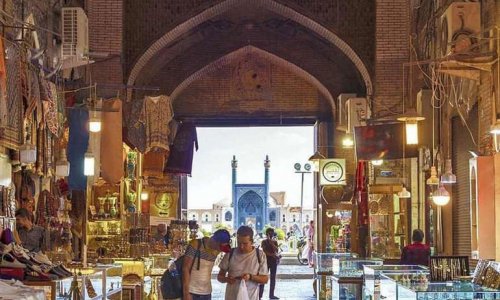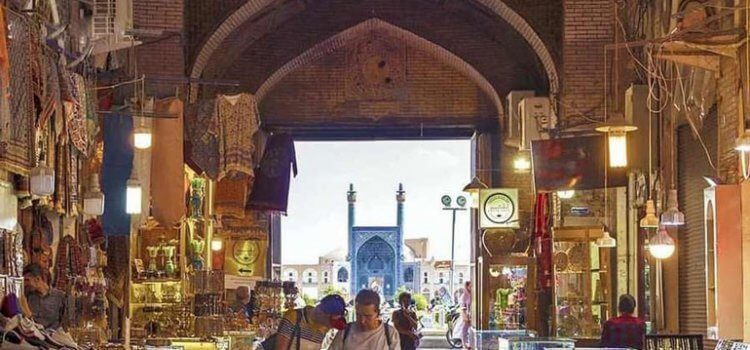Qeysarie Bazaar, The Grand Bazaar of Isfahan
Qeysarie Bazaar, also known as the Royal Bazaar or the Grand Bazaar of Isfahan, is located on the northern side of the Naghsh-e Jahan Square. It is one of the first constructions built in the Naghsh-e Jahan Square, completed in 1605 AC.
The majestic entrance of the Qeysaie Bazaar (completed in 1617 AC) is decorated with eye-catching faience mosaic work. The spandrels are decorated with the image of a mythic creature: a being composed of a human head and a tiger body, shooting its dragon tail. Actually, the mythic symbol represents the ninth astrological, known as Sagittarius. Historians believe that Isfahan was founded in the ninth of the year, and that is why it appears on the spandrels at the top of the Qeysarie Gate.
In the middle of the portal, there are three frescos: the one on the west represents Shah Abbas hunting, the one in the middle shows Shah Abbas fighting the Uzbeks and the third one, on the east, demonstrates Europeans in the Safavid court. Below this frescos, there is a window which once was part of a Sharbat-sara (literally “syrup house”), where the king and his guests used to gather to drink and enjoy the eye-catching view of the Naghsh-e Jahan Square. Nowadays, this building has turned into a museum in which you can enjoy the works of modern Iranian artists. Also, it includes a tea-house, on the roof of the Bazaar, where you can sit, order a drink and enjoy the view of the square.
Flanking Qeysarie’s portal, there were two structures called Naqāreh-Khāneh (Timpani House), used to announce the time at dawn and sunset by playing trumpets and also timpani. Of these structures, there is no trace today.
The Qeysarie Bazaar itself includes a large number of roofed lanes, all lined with shops or hojrehs. At special intervals, usually four lanes meet and make a chahār-sūq. These chahār-sūqs are usually covered with a brick dome and function roughly as a crossroad or square, connecting different parts of the Qeysarie Bazaar together.
In addition to the main corridors, Qeysarie Bazaar is marked by different Saraas, Timchehs and Caravanserais which mostly hold workshops, storehouses and offices of some Bazaaris or merchants working in the bazaar. We strongly advise you to visit Timche Malek, a lavishly decorated Qajar-era building in the Bazaar.
All in all, the Qeysarie Bazaar makes an attraction which every traveler coming to Isfahan should make sure to visit. It is one of the biggest and most splendid bazaars in Iran, providing you with all types of Iran’s souvenirs. As you cross one lane, the fragrance of high-quality spices revitalizes your soul; another lane invites you to feast your eyes on the colorful designs of world-quality carpets; and in other lanes you will come across such beautiful handicrafts the examples of which you cannot find anywhere else in the world. Most important of all, the Qeysarie Bazaar is one of the best places where you can make connections with the local people and immerse yourself in the thousands-year-old culture of Isfahanian people.
Qeysarie Bazaar, also known as the Royal Bazaar or the Grand Bazaar of Isfahan, is located on the northern side of the Naghsh-e Jahan Square.


